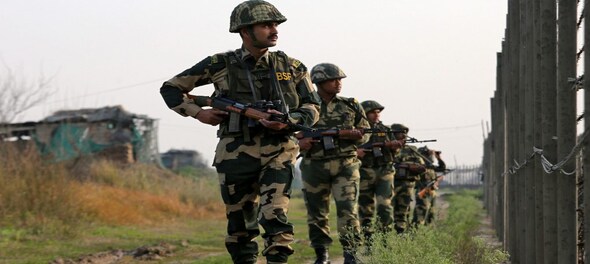
At the Dhubri sector of Indo-Bangladesh border in western Assam, the Border Security Force (BSF) has started using drones as a vital tool against cattle smuggling and cross-border activities. The border force has procured a number of Israeli tethered drones worth Rs 37 lakh each to keep a watch on cattle smugglers along the border. These drones are equipped with day-and-night vision cameras that can capture images within a range of 2 km from a maximum height of 150 meters.
“The tethered drones get power supply continuously from the base and are not much affected by high wind conditions. The drones operating from such a height gives an advantage to aerial surveillance. We have bought several of this kind, specifically for the Dhubri sector,” said Piyush Mordia, Inspector-General of BSF’s Guwahati Frontier.
Checking illegal cross-border activities and cracking down on cattle smugglers has been quite a challenge for security forces. The 61 km border area in Dhubri district, from where river Brahmaputra enters Bangladesh, consists of vast char lands (sand bars) and a number of river channels that make border patrolling a difficult task, especially during monsoon.
Besides the tethered drones, the BSF is also using thermal imaging cameras, EO/IR sensors, pan–tilt–zoom (PTZ) cameras, underwater sensors and underground sensors to detect movement of people, animals, and other objects.
Though cattle smugglers can spot the drones, the BSF IG believes it can act as a deterrence - “the idea is to send them the message that they are being constantly watched,” said Mordia.
Smugglers on the other side of the border have often tried to evade security forces by blending in with the local population and deploying local Indian villagers to carry out well-coordinated smuggling operations. They also pay people to work as lookouts on both sides of the border. Smugglers have been arrested while trying to sneak cattle through Hume pipe culverts under border roads, or using plantain trunks where bovines are bound together and set afloat. They were also found using hollow papaya stems as snorkels to breathe underwater while guiding the cattle across the border.
While cattle smuggling in trucks has reduced, the smugglers have now taken to arterial roads and transport cattle in smaller vehicles. Sometimes, they even walk the cattle to a remote village near the international border from where they are collected and sneaked out at an opportune time.
India shares a 4,096 km border with Bangladesh, and cattle smuggling takes place at various points along this boundary in the five border states of Assam, Meghalaya, Mizoram, Tripura, and West Bengal.
Earlier in March 2018, the then Home Minister Rajnath Singh had inaugurated the smart-fencing Comprehensive Integrated Border Management System (CIBMS) project along the Indo-Bangla border in Dhubri district. Termed BOLD-QIT (border Electronically Dominated QRT Interception Technique), the project inspired by Israeli technology entailed installing technical systems along the unfenced riverine area in Lower Assam.
The CIBMS system now covers the riverine border with data networks generated by microwave communication, optical fiber cables, DMR communication, day-and-night surveillance cameras, and radar system designed for border protection.
“Nobody in the world would do it in a better way,” said Mordia.
The BSF personnel have been seizing at least a dozen cattle every month in the Dhubri sector. These are then handed over to the police. Because of the lack of cattle pounds, the seized cattle are often kept at the police station for weeks before being auctioned. Both BSF and Assam police, however, maintain a proper description of the cattle seized and allow public auction under scrutiny to thwart any attempt by cattle smugglers to try to reclaim the cows in auctions.
BSF has also written to the police in Bihar, Odisha and other hinterland states to check the movement of cattle for tighter checking across the border.
First Published: Nov 5, 2019 9:23 PM IST
Check out our in-depth Market Coverage, Business News & get real-time Stock Market Updates on CNBC-TV18. Also, Watch our channels CNBC-TV18, CNBC Awaaz and CNBC Bajar Live on-the-go!


PM Modi visits Ram Mandir for first time since 'Pran Pratishtha', offers prayers before roadshow
May 5, 2024 8:59 PM
Visiting temples, obliging selfie requests, jabbing rivals – Kangana Ranaut is wooing voters on campaign trail
May 5, 2024 8:23 PM

